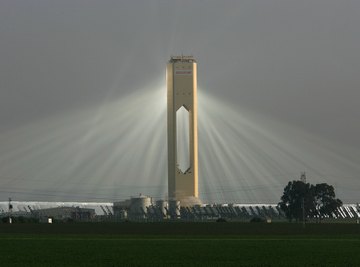
Solar energy has some problems. First, no matter how clear the skies, a solar panel won't produce electricity at night, so a solar energy system needs to have some method of storing energy. And if there is bad weather for an extended time, a solar energy system will provide little output, which means you need to have backup energy generation alternatives available. But those disadvantages are balanced against the low maintenance costs of solar facilities and that the energy source itself -- sunlight -- costs nothing. Add in solar's environmental advantages, and the balance tips in favor of solar energy, leading to record growth in installed solar capacity for more than a decade at the time of publication.
Principles and History
Photovoltaic solar energy, or PV, is generated when electrons absorb sunlight with in a semiconductor material. Scientists developed photovoltaic technology in the 1950s and and adapted it almost immediately to supply electrical power to satellites -- a use that continues today.
Another type of solar energy facility is the solar-thermal plant, also called a concentrating solar power, or CSP, facility. CSP plants use arrays of mirrors to focus sunlight into a heating chamber or linear receiver tubes. Within those elements, heated fluid directly or indirectly drives a turbine generator. Large-scale CSP was successfully demonstrated in the 1980s and continues to be used for some of the largest solar energy plants in the world.
Solar Energy in the U.S.
At the end of 2012, the U.S. Energy Information Administration estimated that the nation had more than 3,500 megawatts of grid-connected solar photovoltaic. Add to that the more than 1,000 megawatts of U.S. CSP energy production estimated by the International Energy Agency, and you reach an impressive total of more than 4,500 megawatts, or 4.5 gigawatts. Although that's a small percentage of the overall energy generation capacity of the United States, the Solar Energy Industries Association says there's enough solar capacity to supply the energy needs of 1 million households.
Global Capacity
Globally, at the end of 2012 Germany led the world with about 25 gigawatts of installed capacity, but other countries are no slackers. Bloomberg reports that there was more than 100 gigawatts of solar capacity online at the end of 2012, with significant growth in China and Japan as well as the United States. The United States and Spain have the largest contribution from CSP, while photovoltaics provide the largest component of installed solar capacity overall.
Future Plans
Although the rapid growth in solar energy capacity in the 2000s -- and particularly since 2005 -- is a good indication that the technology is widely accepted, perhaps an even better indication is provided by the plans for increased growth in the future. In 2013, more than 800 megawatts of CSP energy is scheduled to come online in the United States, and South Africa, Spain and India all have large-scale CSP projects planned. China is expected to be the largest PV consumer in 2013, with projects slated to bring 10 gigawatts of solar electric capacity online. Bloomberg estimates that overall global growth in capacity will reach a new record of 34 gigawatts -- a huge vote of confidence reflecting the widespread acceptance of solar power technology.
References
- BP: Solar Capacity
- U.S. Energy Information Administration: New EIA Data Show Total Grid-Connected Photovoltaic Solar Capacity
- International Energy Agency: Solar (PV and CSP)
- Bloomberg: Global Solar Capacity Tops 100 Gigawatts on Asian Markets
- Bloomberg: China Drives Record Solar Growth Becoming Biggest Market
About the Author
First published in 1998, Richard Gaughan has contributed to publications such as "Photonics Spectra," "The Scientist" and other magazines. He is the author of "Accidental Genius: The World's Greatest By-Chance Discoveries." Gaughan holds a Bachelor of Science in physics from the University of Chicago.
Photo Credits
Denis Doyle/Getty Images News/Getty Images
